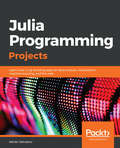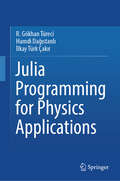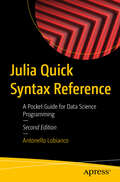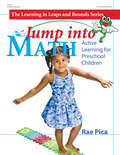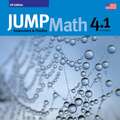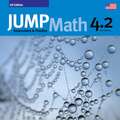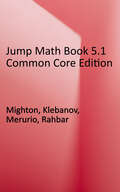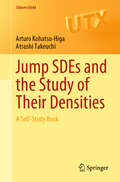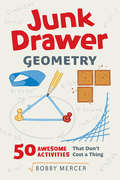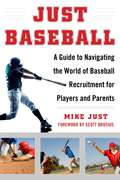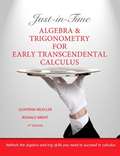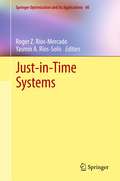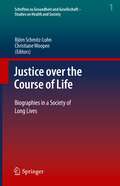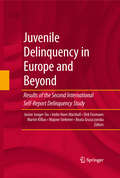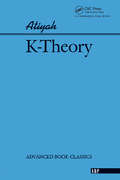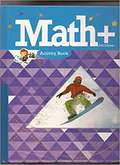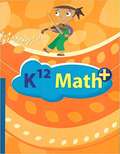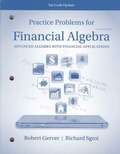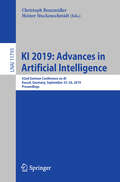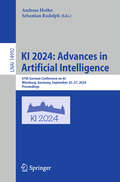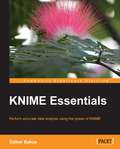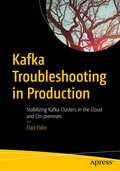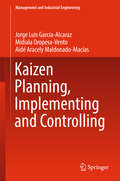- Table View
- List View
Julia Programming Projects: Learn Julia 1.x by building apps for data analysis, visualization, machine learning, and the web
by Adrian SalceanuA step-by-step guide that demonstrates how to build simple-to-advanced applications through examples in Julia Lang 1.x using modern tools Key Features Work with powerful open-source libraries for data wrangling, analysis, and visualization Develop full-featured, full-stack web applications Learn to perform supervised and unsupervised machine learning and time series analysis with Julia Book Description Julia is a new programming language that offers a unique combination of performance and productivity. Its powerful features, friendly syntax, and speed are attracting a growing number of adopters from Python, R, and Matlab, effectively raising the bar for modern general and scientific computing. After six years in the making, Julia has reached version 1.0. Now is the perfect time to learn it, due to its large-scale adoption across a wide range of domains, including fintech, biotech, education, and AI. Beginning with an introduction to the language, Julia Programming Projects goes on to illustrate how to analyze the Iris dataset using DataFrames. You will explore functions and the type system, methods, and multiple dispatch while building a web scraper and a web app. Next, you'll delve into machine learning, where you'll build a books recommender system. You will also see how to apply unsupervised machine learning to perform clustering on the San Francisco business database. After metaprogramming, the final chapters will discuss dates and time, time series analysis, visualization, and forecasting. We'll close with package development, documenting, testing and benchmarking. By the end of the book, you will have gained the practical knowledge to build real-world applications in Julia. What you will learn Leverage Julia's strengths, its top packages, and main IDE options Analyze and manipulate datasets using Julia and DataFrames Write complex code while building real-life Julia applications Develop and run a web app using Julia and the HTTP package Build a recommender system using supervised machine learning Perform exploratory data analysis Apply unsupervised machine learning algorithms Perform time series data analysis, visualization, and forecasting Who this book is for Data scientists, statisticians, business analysts, and developers who are interested in learning how to use Julia to crunch numbers, analyze data and build apps will find this book useful. A basic knowledge of programming is assumed.
Julia Programming for Physics Applications
by R. Gökhan Türeci Hamdi Dağıstanlı İlkay Türk ÇakırNavigating the realm where physics intersects with programming, this book serves as an indispensable guide for students embarking on their journey with Julia. Whether it is plotting equations or analyzing experimental data, mastering computational tools is essential for unraveling the complexities of physical phenomena. Julia, an open-source programming language, emerges as the bridge between simplicity and efficiency. While Python, another open-source language, offers user-friendly syntax, its line-by-line execution often leads to sluggish performance. Julia, however, embodies the ethos of being "as easy as Python but as fast as C/C++," tailored specifically for scientific computing with ongoing developmental enhancements. Notably, Microsoft's AI assistant Copilot is crafted in Julia, showcasing its versatility and adaptability. Within these pages, readers encounter cutting-edge research illustrating Julia's prowess across diverse domains. From streamlined code composition facilitated by modular architecture to the integration of artificial intelligence and graphical visualization, this book illuminates Julia's multifaceted applications. It notably avoids delving into AI algorithms, instead focusing on equipping readers with foundational Julia skills applicable to physics problem-solving. Julia boasts an extensive library ecosystem tailored for scientific computing, empowering users with tools for tasks ranging from differential equation solving to statistical analysis. Its robust support for parallel processing enables swift computations on multi-core systems, a crucial asset for handling voluminous datasets with finesse. Starting with a primer on Julia fundamentals, the book gradually transitions to practical applications across various physics subdomains. From nuclear physics to high-energy phenomena, each chapter offers hands-on exercises that cement comprehension and foster proficiency in employing computational methods to unravel complex physical phenomena. Designed as a precursor to deeper explorations into AI applications within scientific realms, this book lays the groundwork for harnessing Julia's capabilities in physics-centric contexts.
Julia Quick Syntax Reference: A Pocket Guide for Data Science Programming
by Antonello LobiancoLearn the Julia programming language as quickly as possible. This book is a must-have reference guide that presents the essential Julia syntax in a well-organized format, updated with the latest features of Julia’s APIs, libraries, and packages. This book provides an introduction that reveals basic Julia structures and syntax; discusses data types, control flow, functions, input/output, exceptions, metaprogramming, performance, and more. Additionally, you'll learn to interface Julia with other programming languages such as R for statistics or Python. At a more applied level, you will learn how to use Julia packages for data analysis, numerical optimization, symbolic computation, and machine learning, and how to present your results in dynamic documents. The Second Edition delves deeper into modules, environments, and parallelism in Julia. It covers random numbers, reproducibility in stochastic computations, and adds a section on probabilistic analysis. Finally, it provides forward-thinking introductions to AI and machine learning workflows using BetaML, including regression, classification, clustering, and more, with practical exercises and solutions for self-learners. What You Will Learn Work with Julia types and the different containers for rapid development Use vectorized, classical loop-based code, logical operators, and blocks Explore Julia functions: arguments, return values, polymorphism, parameters, anonymous functions, and broadcasts Build custom structures in Julia Use C/C++, Python or R libraries in Julia and embed Julia in other code. Optimize performance with GPU programming, profiling and more. Manage, prepare, analyse and visualise your data with DataFrames and Plots Implement complete ML workflows with BetaML, from data coding to model evaluation, and more. Who This Book Is For Experienced programmers who are new to Julia, as well as data scientists who want to improve their analysis or try out machine learning algorithms with Julia.
Jump Into Math: Active Learning for Preschool Children
by Rae PicaJump into Math is the perfect way to turn children's love of active games into learning opportunities! The activities in each chapter are organized by level of difficulty, and each one incorporates fun, exciting math experiences with movement. Most activities require few or no materials and include related children's books or music to extend the learning. The math skills index is an invaluable reference tool, giving teachers flexibility to plan around children's interests. Whether you use these lively math activities during circle or group time, substitute them for more traditional lessons in math, or use them to reinforce other lessons, you can be sure that the children are moving in leaps and bounds toward understanding mathematics. Research shows that the most effective way for children to learn concepts is to experience them physically. Jump into Math offers just this kind of learning. Activities such as Light and Heavy Words, The Number Hunt, and Three-Legged Creatures will actively engage children as they explore new math concepts!
Jump Math AP Book 4. 1 (US Common Core Revised Edition)
by John Mighton Jump MathEntering the world of JUMP Math means believing that every child has the capacity to be fully numerate and to love math. Founder and mathematician John Mighton has used this premise to develop his innovative teaching method. The resulting resources isolate and describe concepts so clearly and incrementally that everyone can understand them. JUMP Math is comprised of teacher's guides (which are the heart of our program), interactive whiteboard lessons, student assessment & practice books, evaluation materials, outreach programs, and teacher training. The Common Core Editions of our resources have been carefully designed to cover the Common Core State Standards. All of this is presented on the JUMP Math web site: www.jumpmath.org.
Jump Math AP Book 4. 2
by John Mighton Jump MathJump Math AP Book 4.2: Us Common Core Edition, Revised
Jump Math Book 5.1 Common Core Edition
by Mighton Klebanov Merurio RahbarJUMP Math's student Assessment & Practice Books are a great resource for teachers and parents to help children in Grades K-8 build their confidence, skill, and success in math. Created by award-winning mathematician and best-selling author Dr. John Mighton, the AP Books are informed by the latest research on how children learn. They are designed to support students with practicing and mastering math concepts being taught in class and are equally helpful for supporting math learning at home. These essential math resources are printed in two parts, which together cover the full school year. Answer keys for all grades are available at www.jumpmath.org.
Jump SDEs and the Study of Their Densities: A Self-Study Book (Universitext)
by Arturo Kohatsu-Higa Atsushi TakeuchiThe present book deals with a streamlined presentation of Lévy processes and their densities. It is directed at advanced undergraduates who have already completed a basic probability course. Poisson random variables, exponential random variables, and the introduction of Poisson processes are presented first, followed by the introduction of Poisson random measures in a simple case. With these tools the reader proceeds gradually to compound Poisson processes, finite variation Lévy processes and finally one-dimensional stable cases. This step-by-step progression guides the reader into the construction and study of the properties of general Lévy processes with no Brownian component. In particular, in each case the corresponding Poisson random measure, the corresponding stochastic integral, and the corresponding stochastic differential equations (SDEs) are provided. The second part of the book introduces the tools of the integration by parts formula for jump processes in basic settings and first gradually provides the integration by parts formula in finite-dimensional spaces and gives a formula in infinite dimensions. These are then applied to stochastic differential equations in order to determine the existence and some properties of their densities. As examples, instances of the calculations of the Greeks in financial models with jumps are shown. The final chapter is devoted to the Boltzmann equation.
Junk Drawer Geometry: 50 Awesome Activities That Don't Cost a Thing (Junk Drawer Science)
by Bobby MercerFor many children, geometry is best understood as a hands-on subject. What better way to explore concepts such as area, perimeter, and volume than actually measuring area, perimeter, and volume? With this handy resource, children will build polygons out of pipe cleaners and flexible drinking straws, explore Mobius strips made from index cards, and model the Pythagorean Theorem using cheese crackers. These activities and more can be found in Junk Drawer Geometry, which demonstrates that you don't need high-tech equipment to comprehend math concepts—just what you can find around the house or in your recycling bin. Educator Bobby Mercer provides readers with 50 creative geometry project ideas for engaged learning. Each activity includes a materials list and detailed, step-by-step, instructions with illustrations. The projects introduced here include ideas on how to modify the lessons for different age groups, allowing anyone teaching children to use this to excite any classroom. Educators and parents will find this title a handy resource to teach children problem-solving skills and applied geometry, all while having a lot of fun.
Just Baseball: A Practical, Down-to-Earth Guide to the World of Baseball
by Mike JustThat sound, the first crack of the bat.Every year in early spring a special kind of joy comes over those who love America’s favorite pastime, baseball. This feeling is no different for the millions of kids who dream of greatness when they pick up a bat and make their way to the plate.In Just Baseball, Mike Just has created a guide to the world of baseball. Drawing from his own journey to the pros, Just better equips parents and players to make smart decisions as they pursue the game while encouraging players to pursue excellence, maximize their talents, and inspire them to find greater satisfaction in the game. The book covers these topics and more: At what age should youngsters start playing the game? What values will define a player’s baseball character? How important is it to be a team player? What do baseball scouts look for? How can players gain an edge in recruiting? What if your head coach leaves? Is being drafted out of high school a good or bad thing? Baseball is not a one-size-fits-all journey. Learning how to make thoughtful choices that make the most sense for one’s own set of circumstances is all part of getting to the next level. Mike Just’s own experience provides valuable insight for all those who are serious about baseball, and who want to be the best.
Just Enough Carrots
by Stuart J. MurphyElephants, rabbits, and birds shop in this funny grocery store. Can you guess what the little rabbit wants more of? Munchy, crunchy carrots, of course! And fewer of? Squirmy worms and chewy peanuts (yuck!). So why is his mother buying all those cans of worms? MathStart, comparing amounts, level 1.
Just a Second: A Different Way To Look At Time
by Steve JenkinsWhat can happen in just a second, a minute, or an hour?How can we measure time? The flap of a vulture’s wing. A crocodile’s heartbeat. The weight of a baby blue whale. The life of a mayfly. These increments of time may sound a bit strange, but they are all fascinating ways in which we can think about time. But what exactly is time? In Just a Second, the award-winning author-illustrator Steve Jenkins brings forth unique ways to think about time beyond the hands we see every day on a ticking clock. This non-fiction picture book explores time and how we think about it in a different way—as a series of events in the natural world (some of them directly observable, others not) that take place in a given unit of time. Steve Jenkins' extraordinary illustrations will accompany this engaging look at time.
Just-In-Time: Algebra and Trigonometry for Early Transcendental Calculus (Fourth Edition)
by Guntram Mueller Ronald I. BrentJust-in-Time is with you every step of the way, showing you the exact algebra or trigonometry topics that you'll need and pointing out potential problem spots. The easy-to-use Table of Contents features the calculus subject listed directly across from the algebra/trigonometry skills needed to master that topic.
Just-in-Time Systems
by Yasmín A. Ríos-Solís Roger RiosWhether different types of costs are to be reduced, benefits to be maximized or scarce resources to be managed, scheduling theory provides intelligent methods for practitioners and scientists. The just-in-time (JIT) production philosophy has enriched the classical scheduling theory with models that consider characteristics such as inventory costs, set-up times, lot sizing, or maintenance. This edited volume considers the specifics of just-in-time systems. It provides knowledge and insights on recent advances in scheduling theory where just-in-time aspects are considered. Contributions on models, theory, algorithms, and applications, that bring the theory up-to-date on the state-of-the-art of JIT systems are presented. Professionals, researchers and graduate students will find this book useful.
Justice over the Course of Life: Biographies in a Society of Long Lives (Schriften zu Gesundheit und Gesellschaft - Studies on Health and Society #1)
by Christiane Woopen Björn Schmitz-LuhnIn this interdisciplinary book, experts from philosophy, medicine, law, psychology, economics, and social sciences address questions and develop solutions for a well-designed society of long life. Young as well as old people have to actively shape more and more of their life span. At the same time, aging becomes more multifaceted: the individual view on one’s own life course is changing, and the needs and demands for a fulfilled life are diversifying. The implications affect all spheres of life – from education and workplace to health care and the culture of interaction. They require content-related and structural adjustments for a diverse society of longevity in which multiple generations live alongside each other. But how can change be managed responsibly, how can individual and collective responsibility be distributed appropriately, and how can a sustainable and fair social future be ensured?
Juvenile Delinquency in Europe and Beyond
by Josine Junger-Tas Martin Killias Ineke Haen Marshall Beata Gruszczynska Majone Steketee Dirk EnzmannJuvenile Delinquency in Europe and Beyond: Results of the Second International Self-Report Delinquency Study presents the status of juvenile crime and delinquency and its backgrounds in many of the European Union member states as well as in the United States, Canada, Venezuela and Surinam. The book includes information on key issues in juvenile delinquency such as victimization of young people, alcohol and drug use and its relation to juvenile crime, involvement in youth gangs, immigration, family and school and neighborhood situations. It provides insight into different views on what can be considered juvenile crime; what acts are subsumed in its definition and when we can speak about structural delinquent behavior. These insights are based on self-reported information systematically and simultaneously collected from about 70,000 12-15 year old youths in 28 countries. Until recently, the self-report methodology has not been applied on such a large scale in an international context. The results of this survey provide new and unexpected data about those young people who structurally commit criminal acts, as well as on the frequency of the behavior and the conditions that have an impact on offending. The wealth of descriptions and insights in delinquency of all these countries will be of great interest to scholars, students and practitioners because of the special character of the publication; it is a book of reference to everyone interested in the backgrounds of juvenile delinquency.
K-theory
by Michael AtiyahThese notes are based on the course of lectures I gave at Harvard in the fall of 1964. They constitute a self-contained account of vector bundles and K-theory assuming only the rudiments of point-set topology and linear algebra. One of the features of the treatment is that no use is made of ordinary homology or cohomology theory. In fact, rational cohomology is defined in terms of K-theory.The theory is taken as far as the solution of the Hopf invariant problem and a start is mode on the J-homomorphism. In addition to the lecture notes proper, two papers of mine published since 1964 have been reproduced at the end. The first, dealing with operations, is a natural supplement to the material in Chapter III. It provides an alternative approach to operations which is less slick but more fundamental than the Grothendieck method of Chapter III, and it relates operations and filtration. Actually, the lectures deal with compact spaces, not cell-complexes, and so the skeleton-filtration does not figure in the notes. The second paper provides a new approach to K-theory and so fills an obvious gap in the lecture notes.
K12 Student Workbook For Financial Algebra: Advanced Algebra With Financial Applications Tax Code Update, 2nd Student Edition
by Richard J. Sgroi Robert GerverK12 Student Workbook for Financial Algebra: Advanced Algebra with Financial Applications Tax Code Update, 2nd Student Edition 2nd Edition
KI 2019: 42nd German Conference on AI, Kassel, Germany, September 23–26, 2019, Proceedings (Lecture Notes in Computer Science #11793)
by Heiner Stuckenschmidt Christoph BenzmüllerThis book constitutes the refereed proceedings of the 42nd German Conference on Artificial Intelligence, KI 2019, held in Kassel, Germany, in September 2019. The 16 full and 10 short papers presented together with 3 extended abstracts in this volume were carefully reviewed and selected from 82 submissions. KI 2019 has a special focus theme on "AI methods for Argumentation" and especially invited contributions that use methods from all areas of AI to understand, formalize or generate argument structures in natural language.
KI 2024: 47th German Conference on AI, Würzburg, Germany, September 25–27, 2024, Proceedings (Lecture Notes in Computer Science #14992)
by Andreas Hotho Sebastian RudolphThis book constitutes the proceedings of the 47th German Conference on AI, KI 2024, which was held in Würzburg, Germany, during September 25–27, 2024. The 19 full papers, 7 short papers and 5 other papers presented in this book were carefully reviewed and selected from 63 submissions. KI is one of the major European AI conferences and traditionally brings together academic and industrial researchers from all areas of AI, providing an ideal place for exchanging news and research results on theory and applications. The papers have been categorized into the following sections: full technical papers; technical communications; extended abstracts of papers from other AI conferences.
KNIME Essentials
by Gabor BakosKNIME Essentials is a practical guide aimed at getting the results you want, as quickly as possible."Knime Essentials" is written for data analysts looking to quickly get up to speed using the market leader in data processing tools, KNIME. No knowledge of KNIME is required, but we will assume that you have some background in data processing.
Kafka Troubleshooting in Production: Stabilizing Kafka Clusters in the Cloud and On-premises
by Elad EldorThis book provides Kafka administrators, site reliability engineers, and DataOps and DevOps practitioners with a list of real production issues that can occur in Kafka clusters and how to solve them. The production issues covered are assembled into a comprehensive troubleshooting guide for those engineers who are responsible for the stability and performance of Kafka clusters in production, whether those clusters are deployed in the cloud or on-premises. This book teaches you how to detect and troubleshoot the issues, and eventually how to prevent them.Kafka stability is hard to achieve, especially in high throughput environments, and the purpose of this book is not only to make troubleshooting easier, but also to prevent production issues from occurring in the first place. The guidance in this book is drawn from the author's years of experience in helping clients and internal customers diagnose and resolve knotty production problems and stabilize their Kafka environments. The book is organized into recipe-style troubleshooting checklists that field engineers can easily follow when under pressure to fix an unstable cluster. This is the book you will want by your side when the stakes are high, and your job is on the line. What You Will LearnMonitor and resolve production issues in your Kafka clustersProvision Kafka clusters with the lowest costs and still handle the required loadsPerform root cause analyses of issues affecting your Kafka clustersKnow the ways in which your Kafka cluster can affect its consumers and producersPrevent or minimize data loss and delays in data streamingForestall production issues through an understanding of common failure pointsCreate checklists for troubleshooting your Kafka clusters when problems occurWho This Book Is ForSite reliability engineers tasked with maintaining stability of Kafka clusters, Kafka administrators who troubleshoot production issues around Kafka, DevOps and DataOps experts who are involved with provisioning Kafka (whether on-premises or in the cloud), developers of Kafka consumers and producers who wish to learn more about Kafka
Kaizen Planning, Implementing and Controlling
by Jorge Luis García-Alcaraz Aidé Aracely Maldonado-Macías Midiala Oropesa-VentoThis book reports a literature review on kaizen, its industrial applications, critical success factors, benefits gained, journals that publish about it, main authors (research groups) and universities. Kaizen is treated in this book in three stages: planning, implementation and control. The authors provide a questionnaire designed with activities in every stage, highlighting the benefits gained in each stage. The study has been applied to more than 400 managers and leaders in continuous improvement in Mexican maquiladoras. A univariate analysis is provided to the activities in every stage. Moreover, structural equation models associating those activities with the benefits gained are presented for a statistical validation. Such a relationship between activities and benefits helps managers to identify the most important factor affecting their benefits and financial income.
